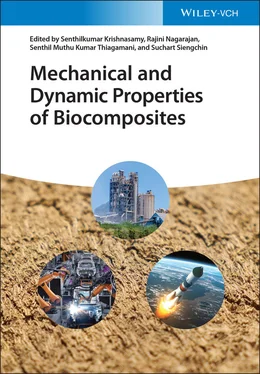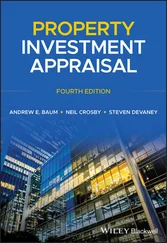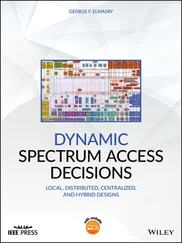Mechanical and Dynamic Properties of Biocomposites
Здесь есть возможность читать онлайн «Mechanical and Dynamic Properties of Biocomposites» — ознакомительный отрывок электронной книги совершенно бесплатно, а после прочтения отрывка купить полную версию. В некоторых случаях можно слушать аудио, скачать через торрент в формате fb2 и присутствует краткое содержание. Жанр: unrecognised, на английском языке. Описание произведения, (предисловие) а так же отзывы посетителей доступны на портале библиотеки ЛибКат.
- Название:Mechanical and Dynamic Properties of Biocomposites
- Автор:
- Жанр:
- Год:неизвестен
- ISBN:нет данных
- Рейтинг книги:4 / 5. Голосов: 1
-
Избранное:Добавить в избранное
- Отзывы:
-
Ваша оценка:
- 80
- 1
- 2
- 3
- 4
- 5
Mechanical and Dynamic Properties of Biocomposites: краткое содержание, описание и аннотация
Предлагаем к чтению аннотацию, описание, краткое содержание или предисловие (зависит от того, что написал сам автор книги «Mechanical and Dynamic Properties of Biocomposites»). Если вы не нашли необходимую информацию о книге — напишите в комментариях, мы постараемся отыскать её.
A comprehensive review of the properties of biocomposites and their applications Mechanical and Dynamic Properties of Biocomposites
Mechanical and Dynamic Properties of BIocomposites
Mechanical and Dynamic Properties of Biocomposites — читать онлайн ознакомительный отрывок
Ниже представлен текст книги, разбитый по страницам. Система сохранения места последней прочитанной страницы, позволяет с удобством читать онлайн бесплатно книгу «Mechanical and Dynamic Properties of Biocomposites», без необходимости каждый раз заново искать на чём Вы остановились. Поставьте закладку, и сможете в любой момент перейти на страницу, на которой закончили чтение.
Интервал:
Закладка:
1.4.1.5 Coir/Silk FRP Hybrid Composites
Silk is a continuous protein fiber characterized by its soft, light, and thin nature and produced by different insects. The silkworm and spun synthesize silk fiber, such as silk cocoon. Large quantities of silk proteins (sericin and fibroin) are produced by the silkworm at the last stage of larval development [31]. These silk proteins are key components of the silk cocoons. Silk fiber, with its huge specific strength and stiffness, have wonderful luster and excellent drape. It prides itself as the strongest material in nature. It however has poor resistance when exposed to sunlight [4].
Using unsaturated polyester matrix, Noorunnisa Khanam et al. [32] in an investigation into the coir/silk fiber hybrid composites used various fiber lengths of 10, 20, and 30 mm. Sodium hydroxide (NaOH) solution was used to treat the coir fibers in order to eliminate their lignin and hemicellulose, thereby causing better bonding of the fiber with the matrix. Composites of 20 mm fiber length showed higher tensile and flexural strengths than the 10 and 30 mm counterparts, as shown in Table 1.6. The tensile, flexural, and compressive strengths were improved significantly in the coir/silk hybrid composites, owing to the NaOH treatment that facilitated the bonding at the coir fiber–polyester matrix interface.
1.4.1.6 Corn Husk/Kenaf FRP Hybrid Composites
Several agricultural wastes such as rice straw, corn husk, and rice husk form a huge quantity of raw natural fibers that are used in polymer composites as materials for reinforcement. Corn husks contain fibers that are rich in cellulose. They are the thin and leafy sheaths that surround corn cobs [33]. Kenaf fiber is important in paper as well as other industrial sectors, as a fiber source.
Kwon et al. [34] used PLA matrix and prepared kenaf fiber and corn husk flour hybrid biocomposites, using a constant fiber to matrix ratio of 30 : 70 by weight ( Table 1.6). Different kenaf/corn husk flour ratios were examined. Before and after extrusion, the aspect ratio was measured for kenaf fibers and its influence on the mechanical behavior was investigated. The result showed that the aspect ratio post‐extrusion had no influence on the values predicted from the Halpin–Tsai equation. Note that the Halpin–Tsai model for predicting elastic response of composites assumes that there is no fiber–matrix interaction and works on the basis of the orientation (geometry) as well as elastic behavior of the matrix and the fibers. They found out that the variation in the Young's modulus of fibers affected the transfer of stress from the matrix to the fiber and reported that a factor of control to optimize mechanical behavior in hybrid biocomposites could be the reinforcements' scale ratio in various aspect ratios.
1.4.1.7 Cotton/Jute and Cotton/Kapok FRP Hybrid Composites
Cotton fibers have been considered as fibers with the greatest importance across the globe. They usually do not have branches and the seed hairs have a single cell (unicellular). They are also rich in cellulose and can elongate up to 30 mm. The wall of cotton fiber does not contain lignin, as distinct from the secondary cell walls of most plants [35]. Cotton fibers are used widely in the textile industry. They possess some advantages, which include excellent drape, high absorbency, as well as good strength.
In the study conducted by De Medeiros et al. [36], the mechanical behavior of woven fabrics of hybrid cotton/jute with phenolic matrix (novolac type) reinforcement was investigated. The results showed strong dependence on the mechanical behaviors on fiber content, fabric characteristics, fiber–matrix adhesion, and fiber orientation. The anisotropy of the composites increased when the test angle was increased and showed dependence on fiber roving/fabric characteristics. There was an inverse proportionality between the mechanical properties and the test angle as the best performance was obtained in the specimen tested at zero degree (that is, jute roving direction). Brittle failure, though controlled, was displayed in the composites that were tested at angles of 45° and 90° as jute fiber directions ( Table 1.6), while at 0° to the longitudinal direction, the tested composites exhibited an uncontrollable catastrophic failure. Jute fiber was identified as a strong material for reinforcement and when combined with cotton could prevent catastrophic failure in the fabric composites. In addition, the results obtained from mechanical behaviors of cotton/kapok FRP hybrid composites are depicted in Table 1.7, showing the effects of accelerated and non‐accelerated weather conditions of alkaline‐treated and untreated specimens. The results of cotton/ramie FRP hybrid composites, with ramie fibers placed longitudinally to the mold length and various ratio, are also shown in Table 1.7.
Table 1.7 Mechanical behaviors of cotton/kapok, cotton/ramie, and jute/oil palm empty‐fruit bunches (OPEFB) FRP hybrid composites.
Source: Nguyen et al. [4]. © 2017, Elsevier.
| Hybrid biocomposites | Fiber ratio (by weight or volume) | Flexural modulus (GPa) | Flexural strength (MPa) | Tensile modulus (GPa) | Tensile strength (MPa) | Impact strength (kJ/m 2) |
|---|---|---|---|---|---|---|
| Cotton/kapok | 3 : 2 | |||||
| Untreated ( V f= 60%) | — | — | 0.884 | 55.70 | 110.53 | |
| Alkali treatment ( V f= 43%) | — | — | 1.635 | 52.87 | 119.25 | |
| Non‐accelerated weather condition ( V f= 46.6%) | 0.709 | 52.40 | — | — | — | |
| Accelerated weather condition ( V f= 46.6%) | 0.703 | 39.55 | — | — | — | |
| Cotton/ramie (ramie fibers placed longitudinally to the mold length) | 10.8 : 41.1 (0° composite) | — | — | — | 90.9 ± 12.7 | — |
| 11.9 : 45.5 (0° composite) | — | — | — | 117.3 ± 13.3 | — | |
| 11.9 : 45.1 (0° composite) | — | — | — | 118.0 ± 6.5 | — | |
| Jute/OPEFB | 1 : 4 | |||||
| OPEFB/Jute/OPEFB | — | — | 2.39 | 25.53 | — | |
| Jute/OPEFB/Jute | — | — | 2.59 | 27.41 | — | |
| Pure OPEFB | — | — | 2.23 | 22.61 | ||
| Pure jute | — | — | 3.89 | 45.55 |
1.4.1.8 Jute/OPEFB FRP Hybrid Composites
Oil palm ( Elaeis guineensis ) is a perennial crop known for its high‐value fruits from which oil is produced. It mostly grows in tropical regions, such as Southeast Asia and West/Southwest Africa. Oil is extracted by stripping the fruits (nuts) from the bunches, a process that leaves the empty‐fruit bunches (EFBs) as waste material [37]. Fibers of oil palm are usually derived from the oil palm empty‐fruit bunches (OPEFB) as well as mesocarp. In composite materials, the OPEFB fibers are mostly used, as they contain the highest hemicellulose content in comparison with pineapple, coir, banana, as well as soft and hardwood fibers [11].
A three‐ply hybrid sample of jute/OPEFB fibers composites with epoxy resin reinforcement was prepared by Jawaid et al. [38], fixing the jute/OPEFB ratio (by weight) at 1 : 4. They investigated the void content, chemical resistance, as well as tensile behaviors of the hybrid composites. From the results obtained, the OPEFB/jute/OPEFB and jute/OPEFB/jute composites showed great resistance to chemicals: toluene (C 7H 8), benzene (C 6H 6), water (H 2O), 40% of nitric acid (HNO 3), carbon tetrachloride (CCl 4), hydrochloric acid (HCl), 5% of acetic acid (CH 3COOH), 20% sodium carbonate (Na 2CO 3), 10% of sodium hydroxide (NaOH), and 10% of ammonium hydroxide (NH 4OH). A lower void content was displayed in the jute/OPEFB/jute than pure OPEFB as well as OPEFB/jute/OPEFB composites, because the mats of the jute fiber adhered better to the epoxy resin with higher compatibility. At the outer ply, the jute fibers withstood the tensional stress due to their high strengths, and the core (OPEFB fiber) absorbed and distributed the stresses evenly within the composite sample systems. Also, it was evident from Table 1.7that the jute/OPEFB hybrid exhibited higher tensile responses (both strength and modulus) as well as improved adhesion bond between the fiber and the matrix, when compared with pure OPEFB composite.
Читать дальшеИнтервал:
Закладка:
Похожие книги на «Mechanical and Dynamic Properties of Biocomposites»
Представляем Вашему вниманию похожие книги на «Mechanical and Dynamic Properties of Biocomposites» списком для выбора. Мы отобрали схожую по названию и смыслу литературу в надежде предоставить читателям больше вариантов отыскать новые, интересные, ещё непрочитанные произведения.
Обсуждение, отзывы о книге «Mechanical and Dynamic Properties of Biocomposites» и просто собственные мнения читателей. Оставьте ваши комментарии, напишите, что Вы думаете о произведении, его смысле или главных героях. Укажите что конкретно понравилось, а что нет, и почему Вы так считаете.












